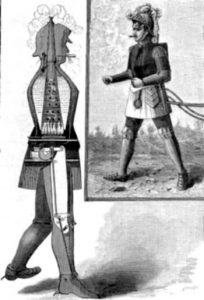Androids of various forms have long been in existence, with the
earliest ones dating back to the Middle Ages. In the 13th century,
Alburtus Magnus invented one of the first known automated iron men.
In the Renaissance, androids became very popular; one of the best
preserved examples is a mandolin-playing lady attributed to
Giannello Torriano of Cremona (c. 1500-1585).
The walking steam-man in the engraving dated 1893, was developed
by the Canadian inventor George Moore. Constructed of tin, the body
contained a steam boiler supplied with a gasoline engine.
As seen in the cross section, an exhaust pipe led from the
engine to the nose of the figure, from whence steam escaped when
the machine was in motion. Through the head a smoke flue was
carried, allowing the products of combustion to escape from the top
of the helmet.
Also contained within the 6 foot tall body was a 3,000 R.P.M.
motor and a gear train for motion. The spurs of the figure would
catch on the surface on which it was walking and thus give it
appropriate traction. The steam-man was connected to the end of a
horizontal bar about waist high, which in turn was fastened to a
vertical standard in the center of a track.
Thereby supported, the android could walk around in a circle at
quite a rapid rate of progress about 5 M.P.H.
The action of the steam-man was said to have been quite a
natural phenomenon, with the hip, knee, and ankle motion of the
legs faithfully imitating that of human movement. It was also
remarked that in full operation it could not be held back by just
two men pulling against it.
Moore had plans for another mechanical man designed for use on
the open streets to draw a wagon containing 10 musicians.
#249 ©1975, Saul Ash Co. 48071 USA.





